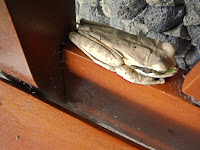Arenal
Volcano and Los Fortuna, Costa Rica
On our return trip from Las Chiles, we stopped at Arenal
Volcano and the adjacent town La Fortuna. One of Costa Rica's most notable
natural features is the Arenal Volcano. There are 9 volcanos in Costa Rica.
This impressive volcano resides within the 29,960-acre Arenal Volcano National
Park, and the Arenal volcano measures at least 5,358 feet tall. Although the volcano entered into a resting
phase in 2010 – meaning that its eruptions have paused – it is still a stunning
sight, and sometimes gives off smoke to remind you that it is still active, but
just sleeping.

 |
| Lake Arenal |
On Monday, July 29, 1968 at 7:30 AM, the Arenal Volcano
suddenly and violently erupted. The eruptions continued unabated for several
days, burying over 15 square kilometers with rocks, lava and ash. When it was
finally over, the eruptions had killed 87 people and buried 3 small villages
and affected more than 232 square kilometers of land. Crops were spoiled,
property was ruined, and large amounts of livestock were killed.
At the height of its ferocious activity, the volcano
flung giant rocks – some weighing several tons – more than a kilometer away at
a rate of 600 meters per second. These explosions would go on to form three new
active craters.
As the three towns were destroyed on the western side of
the volcano, a town by the name of El Borio on the east side was untouched and
unharmed. After the volcano ceased to erupt, El Borio (was founded in the mid
1930s) and was renamed La Fortuna, which means "the fortunate",
referring to its luckiness that the volcano erupted to the west and not the
east.
The town is quaint but also very much a tourist
magnet. It has lots of souvenir stores
and tour groups. Since we enjoy more of
the natural environment, we didn’t spend much time in the town. It is worth a visit since the people are very
helpful.
We did spend a day at Baldi Hot Springs Resort & Spa. Baldi
has 25 thermo mineral hot water pools flowing naturally from the base of
the volcano. The hottest pools start at
the top and temperatures cool off as you descend ranging in temperatures from
152 116, 113, 110, 109, 104, 102, 100, 93 º F.
The top pools were way too hot for us, but I think everyone could find a
temperature that is right for them. It
is quite impressive as you walk around the property. They have built bars that extend into the
pools.
 |
| The top and hottest pool |

To spend any time at Baldi you have to pay! It costs us $92 for us to use the pools and
have a buffet dinner. Please, please
skip the buffet, unless it is quantity not quality you are looking for. The food was bad in our opinion. Also I feel like I should say something about
the pools. They bring in bus-loads of
people who have also paid the entrance fee.
Some of the buses are only children.
They are allowed to run free and I do mean run.

Next time we are there, we would much prefer
to check out the natural springs and avoid the crowds at Baldi.
We stayed at the Arenal Observatory Lodge & Spa (AOL
for short). La Fortuna has its abundance
of large resorts. We decided on AOL
because it is just over 1.7 miles south of the Arenal volcano and less crowded than the large resorts, with a
spectacular view of the volcano as well as an impressive view of nearby Arenal Lake
and surrounded by 870 acres of incredible rain forest offers the area's most
stunning views of the volcano and Arenal Lake.
We elected the smaller AOL because we wanted to hike and bird watch and
just watch the volcano. We stayed in the
Smithsonian rooms at AOL. These rooms feature
a huge picture windows giving you a majestic view of the volcano from the
comfort of your bed.
 |
| Porch that overlooks the volcano |
 |
| View from our Porch |
Also AOL has its own waterfall right on the property. We hiked to the waterfall in the rain. It was great.
It was our own private waterfall for the day.
And for those of you who know me I am totally
afraid of heights, but I managed to walk across the hanging bridge. My motivation was the swimming pool and hot
tub on the other side.
 |
| Our private hot tub |
 |
| Leaf cutters busy at work |











































